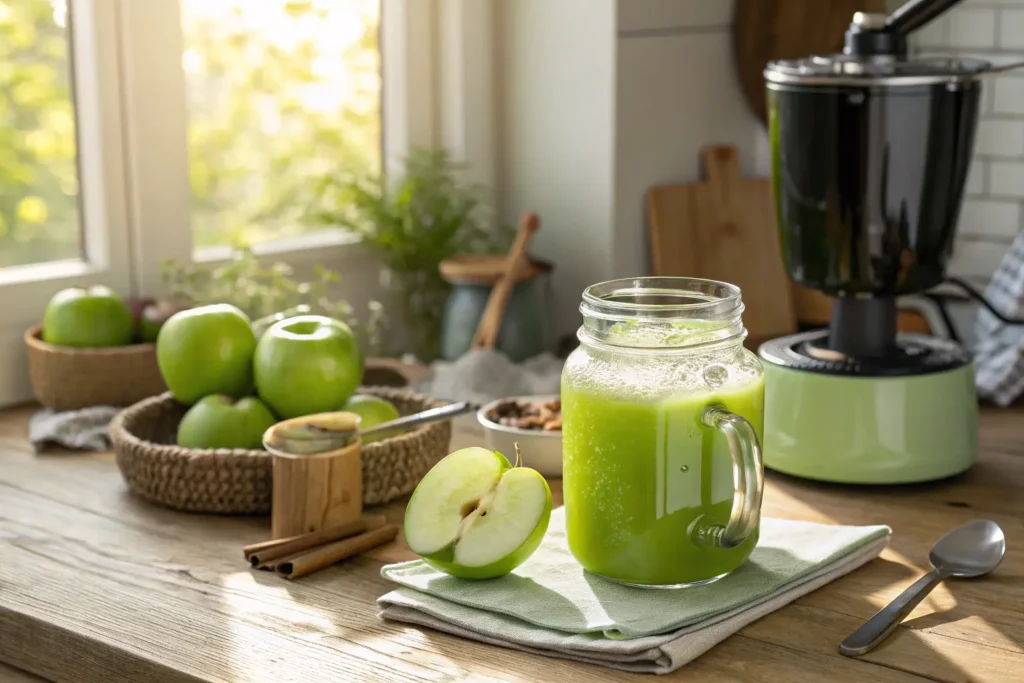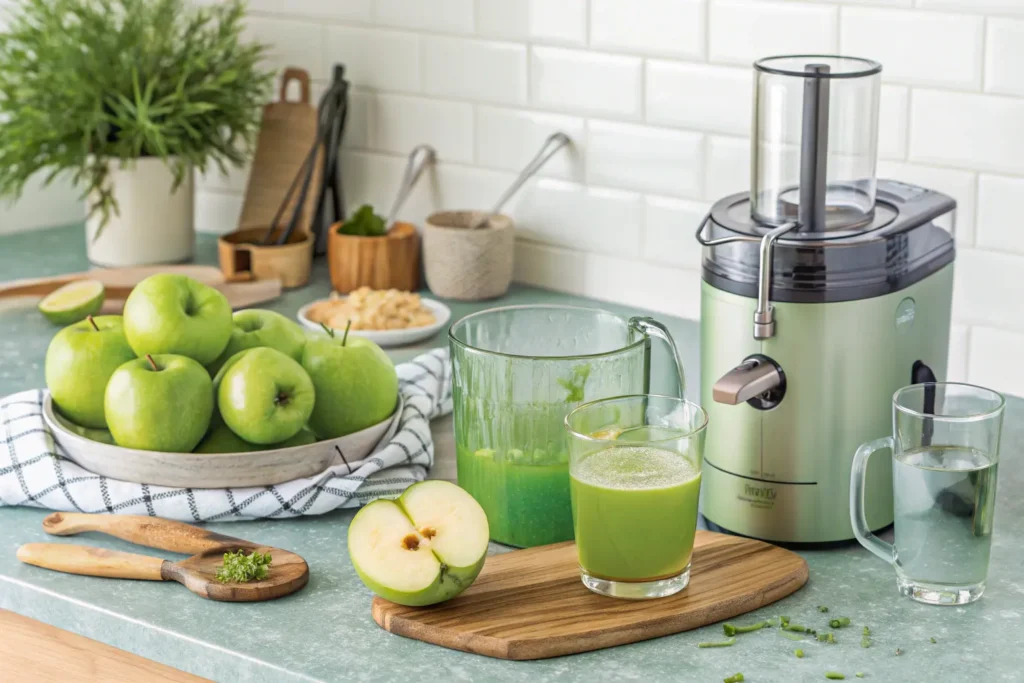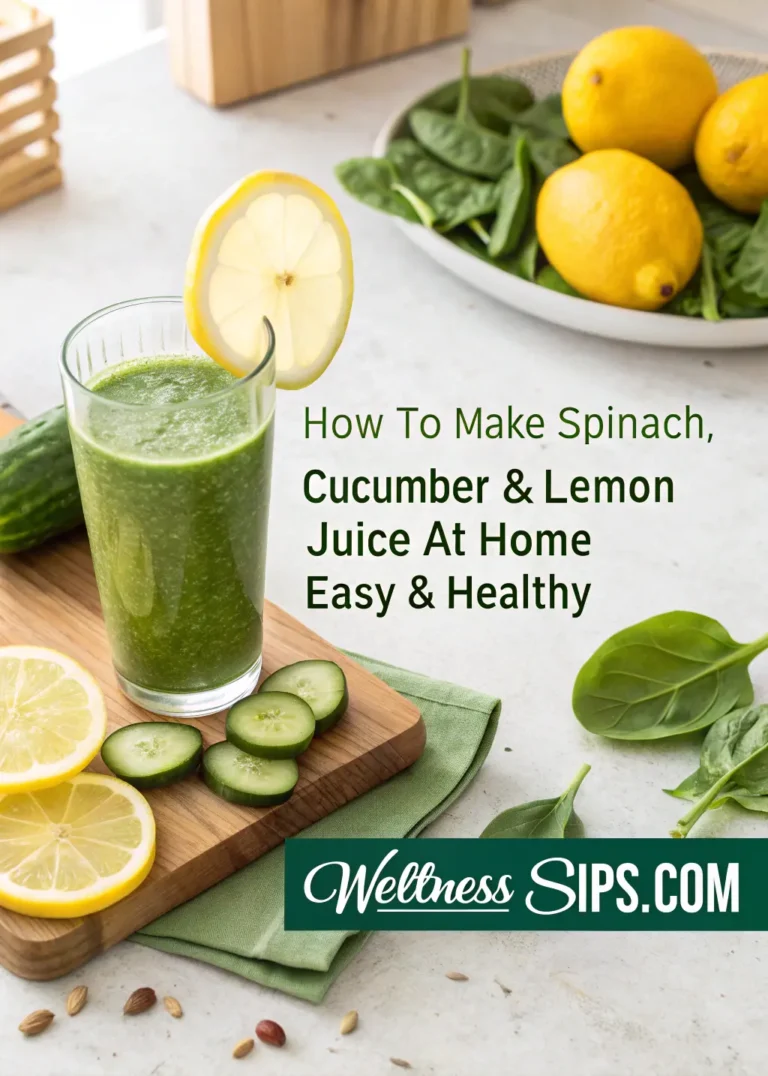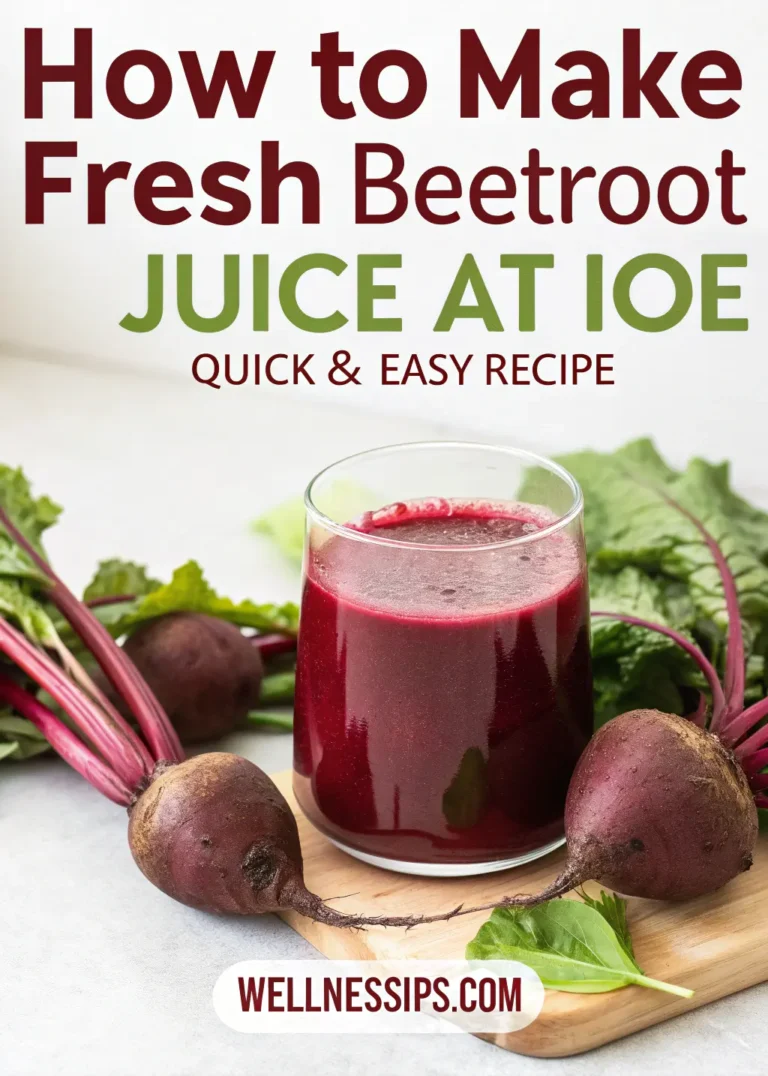How to Make Fresh Green Apple Juice at Home
Picture this: you bite into a perfectly crisp green apple, and that incredible burst of tangy sweetness floods your senses. That moment of pure refreshment doesn’t have to end with the last bite. Creating your own green apple juice at home captures that exact experience in liquid form, giving you complete control over what goes into your glass.
When you make green apple juice yourself, you’re not just preparing a beverage – you’re crafting a healthier lifestyle choice for your entire family. Unlike store-bought versions loaded with preservatives and artificial additives, your homemade creation delivers pure, unadulterated apple goodness that your body will thank you for.
Table of Contents
Why Choose Homemade Green Apple Juice Over Store-Bought?
Your local grocery store shelves overflow with juice options, but here’s what they won’t tell you: most commercial apple juices contain added sugars, artificial flavors, and preservatives that dilute the natural benefits of fresh fruit. When you create green apple juice in your own kitchen, you maintain complete ingredient transparency.
Fresh green apple juice contains significantly higher vitamin C levels compared to processed alternatives. While commercial versions lose nutrients during pasteurization and storage, your homemade blend preserves these essential vitamins right up until the moment you drink it.
From a financial perspective, making your own juice makes sense too. A single bottle of premium organic apple juice can cost $4-6, while purchasing the equivalent amount of fresh green apples typically runs $2-3. Over time, these savings add up substantially, especially if your family enjoys juice regularly.

Essential Equipment for Making Green Apple Juice
Before diving into juice-making, you’ll need the right tools. Don’t worry – you probably already own several of these items.
Must-Have Kitchen Tools
Juicer Options:
- Centrifugal juicers work excellently for beginners, processing apples quickly and efficiently
- Masticating juicers extract maximum nutrients while preserving enzyme integrity
- Manual methods using blenders require more effort but cost significantly less
Supporting Equipment:
- Sharp paring knife for apple preparation
- Sturdy cutting board
- Large mixing bowls for collecting juice
- Fine mesh strainer or cheesecloth
- Airtight storage containers
If you don’t own a dedicated juicer, your high-speed blender can absolutely handle this task. Simply blend chopped apples with minimal water, then strain the mixture through cheesecloth for smooth, pulp-free juice.
Selecting the Perfect Green Apples for Juicing
Not all green apples create equally delicious juice. Your apple selection directly impacts both flavor and nutritional content.
Best Varieties for Juicing:
- Granny Smith apples deliver that classic tart flavor most people associate with green apple juice
- Pippin apples offer excellent balance between sweet and sour notes
- Crispin apples provide natural sweetness that reduces the need for added sugars
When shopping for apples, examine each fruit carefully. Choose specimens with firm, unblemished skin that feels solid when gently pressed. Avoid apples with soft spots, wrinkled skin, or those that feel hollow when tapped.
Peak apple season runs from September through November, making this the ideal time to stock up. However, properly stored apples maintain quality for weeks, allowing you to enjoy fresh juice year-round.
Step-by-Step Green Apple Juice Recipe
Ingredients
| Ingredient | Quantity | Purpose |
|---|---|---|
| Fresh Green Apples | 6-8 medium | Primary juice base |
| Filtered Water | 1/4 cup | Blending assistance |
| Fresh Lemon Juice | 1-2 tablespoons | Prevents oxidation |
| Honey | 1-2 teaspoons | Natural sweetener (optional) |
Preparation Method
Step 1: Apple Preparation (5 minutes) Thoroughly wash your apples under cold running water, removing any surface dirt or residue. Cut each apple into quarters, removing the core and seeds if using a blender method. Juicer users can leave cores intact, as most machines handle them effectively.
Step 2: Juice Extraction (10-15 minutes) For juicer users, feed apple pieces slowly into your machine, alternating between different pieces to prevent clogging. If using a blender, combine apple chunks with water and blend on high speed for 60-90 seconds until completely liquefied.
Step 3: Straining and Finishing (5 minutes) Blender users should strain the mixture through fine mesh or multiple layers of cheesecloth, pressing the pulp to extract maximum liquid. Add lemon juice immediately to prevent browning, then taste and adjust sweetness with honey if desired.
Pro Tips for Maximum Success
- Chill your apples beforehand for better juice yield
- Alternate between different apple pieces when using a juicer
- Save the leftover pulp for composting or baking projects
- Process juice immediately after preparation for optimal freshness
Flavor Variations and Enhancement Ideas
Basic green apple juice tastes fantastic, but experimenting with additions creates exciting new flavor profiles.
Popular Combinations:
- Mint-infused green apple juice: Add 8-10 fresh mint leaves during blending for refreshing summer drinks
- Spiced apple juice: Include a cinnamon stick and pinch of nutmeg for warming autumn flavors
- Apple-cucumber blend: Combine 4 apples with 1 large cucumber for hydrating, low-calorie refreshment
Customization by Dietary Needs:
- Diabetic-friendly versions skip added sweeteners and use sparkling water for dilution
- Weight-loss variations incorporate fiber-rich vegetables like celery or spinach
- Kid-friendly versions blend apples with milder fruits like pears for reduced tartness

Storage and Preservation Methods
Fresh green apple juice maintains peak quality for 2-3 days when refrigerated in airtight glass containers. Always store your juice between 32-40°F for optimal preservation.
Storage Options Comparison
| Method | Duration | Quality Retention |
|---|---|---|
| Refrigeration | 2-3 days | 95% |
| Freezing | 3-6 months | 80% |
| Canning | 12+ months | 70% |
Watch for spoilage signs including off odors, color changes, unusual fizzing, or mold growth. When in doubt, discard the juice rather than risk illness.
Freshness Extension Tips:
- Fill storage containers completely to minimize air exposure
- Add vitamin C tablets to prevent oxidation
- Use clean utensils when serving
- Label containers with preparation dates
Health Benefits of Fresh Green Apple Juice
Your homemade green apple juice delivers impressive nutritional benefits that support overall wellness.
Key Nutrients Per 8-Ounce Serving:
- Vitamin C: Approximately 95mg (supporting immune function)
- Potassium: 195mg (promoting heart health)
- Natural antioxidants including quercetin and catechin
- Beneficial plant compounds that support digestive health
Unlike processed alternatives, fresh juice retains heat-sensitive vitamins and enzymes that processing destroys. The natural fiber content (when unstrained) supports digestive health, while potassium helps regulate blood pressure.
Research indicates that regular consumption of fresh apple juice may help reduce cholesterol levels and support cardiovascular health, though moderation remains important due to natural sugar content.
Troubleshooting Common Issues
Even experienced juice makers encounter occasional challenges. Here’s how to address the most frequent problems:
Taste Issues:
- Overly tart juice: Gradually add natural sweeteners or blend with sweeter apple varieties
- Bland flavor: Check apple ripeness and consider adding complementary spices
- Too sweet: Balance with fresh lemon juice or dilute with sparkling water
Texture Problems:
- Excessive pulp: Double-strain through finer mesh
- Foamy appearance: Allow settling time or skim foam before serving
- Rapid browning: Increase lemon juice quantity in future batches
Remember that juice-making improves with practice. Your first attempts might not achieve perfection, but each batch teaches valuable lessons about apple selection, processing techniques, and flavor preferences.
Conclusion
Creating fresh green apple juice at home transforms simple fruit into liquid nutrition that energizes your day and supports your family’s health goals. You’ve now discovered the complete process, from selecting premium apples to perfecting your personal flavor profile.
This journey extends beyond mere beverage preparation – it represents a commitment to healthier living and ingredient transparency. Every glass you create contains pure, natural goodness without artificial additives or excessive processing.
Your kitchen now serves as your personal juice bar, ready to deliver restaurant-quality refreshment whenever cravings strike. The money you save, combined with the health benefits you gain, makes this skill invaluable for long-term wellness.
Frequently Asked Questions About Green Apple Juice
Q: How many green apples produce one cup of juice? A: Typically, 3-4 medium green apples yield approximately 8 ounces of fresh juice, depending on variety and extraction method.
Q: Can I make green apple juice without specialized equipment? A: Absolutely! High-speed blenders work excellently when combined with straining through cheesecloth or fine mesh.
Q: Why does my green apple juice turn brown quickly? A: Oxidation causes browning. Adding 1-2 tablespoons of lemon juice immediately after preparation prevents this discoloration.
Q: How much green apple juice should I drink daily? A: Nutritionists recommend limiting fruit juice intake to 4-6 ounces daily due to natural sugar content.
Ready to transform your kitchen into a juice-making powerhouse? Start with just a few fresh green apples today, and discover how simple ingredients create extraordinary results. Your taste buds – and your body – will celebrate this delicious step toward healthier living!







